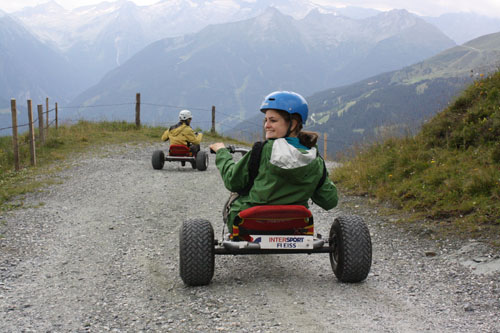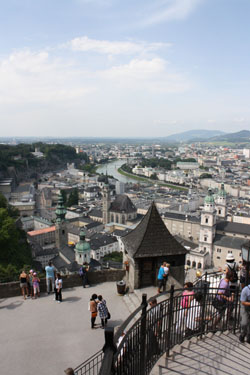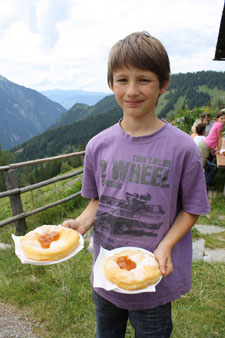By Susan Farewell

Not sure I knew what the Habsburg Empire was when I was 14. And frankly, had I studied it in school back then, I’m not sure I would have cared much at all. Its history can be mind-boggling to read, as it spans several centuries and includes a long string of emperors acquiring, losing and fighting over land.
This all changed when I was an 18-year-old student backpacking through Europe and found myself standing in the main hall of the Imperial Palace in Innsbruck. Suddenly I cared about this era of history. Who exactly was Maximilian I and why does he have such an opulent tomb? And what do you mean Austria used to be bigger and had a coastline?
I was bitten by the history bug, the sort that you can only keep from biting you by traveling. It seemed to me that this little landlocked country that’s more vertical than horizontal, was the center of everything that had anything to do with modern European history.
This is just one of the reasons I decided to take my daughter Justine to Austria during her summer vacation. But I know full well that a little culture and history can go a long way with a teenager and spending two weeks touring palaces and cathedrals is not exactly “fun” after a while. So I thought it best to divide our time between a few small cities and the alps in the western part of the country, combining plenty of culture with all-out fresh-aired adventure.
Salzburg: A Few of My Favorite Things
We started by flying to Salzburg, which had left an indelible impression on me on that same trip as a student. With its maze of Medieval streets and wrought-iron signs, its Old Town (Altstadt) is a distillation of Europe the way you think it should be. It didn’t take long for us to find Café Tomaselli, which quickly became our favorite place for afternoon cake and people watching. When not there agonizing over whether to order a strudel or chocolate cake (and I, the ice coffee—which is made with ice cream), we walked ourselves into oblivion, ignoring the proliferating blisters on our feet. We wanted to see and do everything, but perhaps the main reason we kept pushing on was we just loved being part of it all. The Salzburg Festival was going on at the time and the streets had an ongoing tipsy air of carnival. me on that same trip as a student. With its maze of Medieval streets and wrought-iron signs, its Old Town (Altstadt) is a distillation of Europe the way you think it should be. It didn’t take long for us to find Café Tomaselli, which quickly became our favorite place for afternoon cake and people watching. When not there agonizing over whether to order a strudel or chocolate cake (and I, the ice coffee—which is made with ice cream), we walked ourselves into oblivion, ignoring the proliferating blisters on our feet. We wanted to see and do everything, but perhaps the main reason we kept pushing on was we just loved being part of it all. The Salzburg Festival was going on at the time and the streets had an ongoing tipsy air of carnival.
We stuffed ourselves on the well-known cultural attractions including Mozart’s birthplace, the prince-archbishop’s palace (Residenz) and the 900-year-old Festung Hohensalzburg, the fortress which looms over the city. But we also spent some time in the not-so-famous ones. I loved seeing the excavated mosaics under the Residenz near the cathedral; Justine was mesmerized by the 360-degree painting of Salzburg as it was in 1829 which is housed in the Salzburg Museum. Everything we saw gave us a bit more insight into the history and left us wanting to learn more.
We were also eager to see the settings of scenes that had been in The Sound of Music, all of which were ripe in our minds, having watched the movie right before the trip. We opted for the four-hour bus tour, which—in spite of my initial fears of it being too canned and Hollywood sappy—was extremely well done. Justine was delighted to see the glass gazebo where Rolf and Liesl danced to “Sixteen Going on Seventeen,” the street where Maria sang “I have Confidence” and the church where the Captain and Maria got married. But it was me who actually got all misty eyed when our entire busload of tourists started singing the Rodgers and Hammerstein songs as we rolled through the fairytale landscape.
After a few days in Salzburg and several “I’ve never had such a great meal in my life” restaurant experiences (don’t miss Blaue Gans --classic Austrian cuisine with a contemporary touch) as well as performances in various venues around town (including a string quartet in the Marble Hall of Mirabell Palace and the Mozart Dinner Concert in the Baroque Hall of the Restaurant Stiftskeller St. Peter), it was time to say “So long, Farewell, Auf Wiedersehen, Good-bye” to Salzburg.
Climb Every Mountain: Salzburgerland
We spent the next couple of days exploring Salzburgerland, the countryside outside Salzburg. It’s wide-angle lens time when exploring this region—craggy mountains, lakes and rivers, castles—“The Hills are Alive” country. This included touring the salt mines in Hallein, the highlight of which is a series  of chutes that take you deep into the caverns. Definitely fun. From there, we went on to visit the World’s Largest Ice Cave in Werfen. After a 20 minute walk to a cable car ride up a sheer cliff, followed by another 20 minute walk, we embarked on a 700-step guided journey through the inside of a mountain. In pitch dark, punctuated with the light of hand-held magnesium wicks carried by the guides and line leaders, we gaped at voluminous ice sculptures, many of which resembled figures brought to life by our great storytelling guide. of chutes that take you deep into the caverns. Definitely fun. From there, we went on to visit the World’s Largest Ice Cave in Werfen. After a 20 minute walk to a cable car ride up a sheer cliff, followed by another 20 minute walk, we embarked on a 700-step guided journey through the inside of a mountain. In pitch dark, punctuated with the light of hand-held magnesium wicks carried by the guides and line leaders, we gaped at voluminous ice sculptures, many of which resembled figures brought to life by our great storytelling guide.
One night, we stayed in the very cute town of Goldegg which is intensely Austrian with a glassy lake, traditional wood houses festooned with window-box blossoms and mountains all around. Just 40 minutes or so south of Salzburg, it’s an easy getaway for city-dwellers and come winter, it’s all about skiing.
From there, we did a couple of different excursions including a walk along the river and waterfalls of Liechtensteinklamm (the Liechtenstein Gorge) in St. Johann and a hike to Maurachalm, a dairy farming hut in the mountains, which is part of Austria’s impressive hut-to-hut hiking system. The latter—which we reached via funicular from St. Johann-Alpendorf and then after hiking for about two hours—was definitely one of those “have I died and gone to heaven” kind of places. As we sat at a long table in the drenching sun, the alpine views and fellow family hikers all around, we picked at a platter of meats and cheeses accompanied by fresh-baked farmer’s bread and drank almdudler, a ginger ale-like soft drink, “only better,” according to Justine. Then we helped ourselves to freshly prepared apricot krapfen, which is a donut-like pastry. 
Little did we know that all of this physical activity was just warming us up for our fixed-rope (known as Klettersteig) rock climbing experience in Bad Hofgastein, which was next on our itinerary. After settling into our hotel and a bit of relaxing in the thermal spa (for which the area is known along with skiing) and a good night’s sleep, we met Gerhardt, our guide, at the foot of Schlossalm. Two cable cars later, we were near the summit and the rocky outcropping route, Hirschkar, which we were scheduled to climb.
Neither Justine or I had ever gone rock climbing, unless you count the walls at various gyms and resorts we’ve been to over the years. So upon seeing the jagged outcroppings that stuck out of the mountaintop like a figurehead on a sailing ship, we looked at each other wide-eyed and silent. Really? Were we really about to do this?
After a short introductory lesson about caribiners and fixed rope climbing, we were on our way. In hindsight, I can say it was easy, but the truth is, both of us had to struggle through our fears to go the distance. Every step was a challenge—physically and mentally. But in the end, we stood triumphantly next to the cross on the top of the mountain, with an overwhelmingly profound sense of accomplishment.
And the best part of all…we got to trundle down the mountain in a three-wheeled cart called a  Monsterroller (as pictured above). Every mountain should have these. They’ve got hand brakes like bikes, but basically one just sits back and enjoys the ride. No pedaling necessary. You just go down, controlling the speed as you will. Monsterroller (as pictured above). Every mountain should have these. They’ve got hand brakes like bikes, but basically one just sits back and enjoys the ride. No pedaling necessary. You just go down, controlling the speed as you will.
More Peak Experiences: Tyrolean Region
From Bad Gastein, we took a train to Kitzbüehel, which most people know as a ski town (it’s where the famous Hahnenkamm race takes place every year). In the non-snowy seasons, it more than holds its own with a myriad of outdoor activities including hiking, cave canyoning, mountain biking, white-water rafting, paragliding and a Klettersteig route that culminates at an altitude of 6,800 feet. On top of that, it has some outstanding restaurants including Hallerwirt, which prides itself on its traditional Tyrolean cuisine, and Gasthof Hagstein, from which you won’t be able to take your eyes off the view.

Kitzbüehel is just an hour away from Innsbruck, which was our final destination. Always a crossroads as the junction of two routes across the eastern Alps, it has the feel of being at the center of things with a busy Old Town, many galleries, shops, cafes and nightlife. It’s also at the crossroads of history, where you can see Gothic, Renaissance and Baroque buildings but also feel as if you’ve been pneumatically-tubed to the future in the ultra-modern funicular that swoops you to the Nordkette from the center of town in 20 minutes.
From the top, you can see the mountains of Germany and Northern Italy nearby. You can even hike over to them. I found myself wishing I had more time to embark on such an adventure. Maybe on our next trip to Austria. My daughter’s already begging me to go back. I won’t be surprised if years from now, she returns with her own daughter.
Photos: From top to bottom, Justine in a mountain cart at Schlossalm in Bad Hofgastein; view of Salzburg from Hohensalzburg; window box of flowers in Goldegg; boy at Maurachalm holding apricot krapfen; Susan climbing fixed-rope route Hirschker; a regional dish called Kaesspaetzle at Hallerwirt Restaurant in Kitzbüehel. All photos by Justine Seligson with the exception of the photo of Justine in the mountain cart, which is by Susan Farewell.
|

